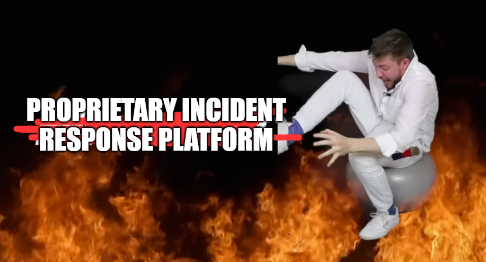From Whiteboards to Integrated Workflows: A Modern Journey in Incident Management
7 May 2025 · 4 min read
humble beginnings
In the early days of security operations, incident response revolved around a single room, a whiteboard, and a handful of analysts who could shout updates across a desk. Evidence lived on network shares, timelines were scribbled with dry-erase pens, and coordination was effortless—until teams began working across time zones. Suddenly, hand-offs spanned across regions, leadership expected real-time updates, and a process once designed for a pirate crew buckled under a grand line.
one small step for man
The first attempt to digitise the war room came in the form of a proprietary incident response solution. On paper, it seemed ideal: secure, with built-in case management and an incident wizard? 🧙 In practice, however, three problems emerged. Licencing was sold per user, so only senior analysts could log in; everyone else waited for status emails. Integration with the SIEM and threat intelligence feeds was non-existent, forcing analysts to copy IOCs by hand. And worst of all, the crappy user interface turned a promised "easy-to-use platform" into a single point of frustration. The tool survived, but only as a repository for post-incident documentation. Frustration with the proprietary solution led the team to an open-source counterpart. Because it was
licence-free, every responder—and every stakeholder—could collaborate in the same space. The platform
shipped with connectors that enriched artefacts automatically, so as soon as a hash or domain landed in the
case, additional context appeared in seconds. ChatOps integration meant that the conversation around the
incident, complete with time stamps and threaded actions, was preserved as evidence. A cryptographic vault
hashed every upload, providing immutability and a defensible chain of custody. The honeymoon period, however,
revealed two familiar truths about open source: bugs arrive unannounced, and expertise can bottleneck around
a single engineer. Report generators defaulted to the wrong language, on-premises deployment limited the use
of cloud extensions, and when the resident SME took leave, maintenance became a backlog.
Frustration with the proprietary solution led the team to an open-source counterpart. Because it was
licence-free, every responder—and every stakeholder—could collaborate in the same space. The platform
shipped with connectors that enriched artefacts automatically, so as soon as a hash or domain landed in the
case, additional context appeared in seconds. ChatOps integration meant that the conversation around the
incident, complete with time stamps and threaded actions, was preserved as evidence. A cryptographic vault
hashed every upload, providing immutability and a defensible chain of custody. The honeymoon period, however,
revealed two familiar truths about open source: bugs arrive unannounced, and expertise can bottleneck around
a single engineer. Report generators defaulted to the wrong language, on-premises deployment limited the use
of cloud extensions, and when the resident SME took leave, maintenance became a backlog.
one giant leap for mankind
With operational maturity rising, leadership began asking for a platform that could handle incident response under one umbrella—supported by someone who answers the phone at three a.m. The natural next step was an enterprise solution equipped with a major-incident module. Because it shares data with the broader department, security incidents could automatically inherit asset information, maintenance windows, and custodian details. Robust APIs could allow alerts from the SIEM to open tickets instantly, while chat integrations could preserve the conversational timeline without manual exports.lessons learned
- Plan for growth, not the current headcount.
- Prioritise integration, or risk losing time and context.
- Treat chats as evidence, with export and retention plans.